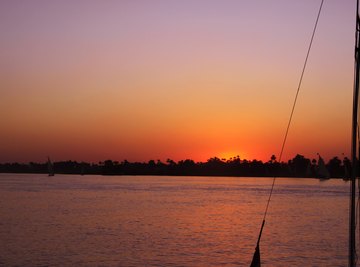
Seasonal rains in the Ethiopian Highlands prompt the annual summer flood of the Nile River, arguably the longest river in the world. For thousands of years the flooding of the Nile river made possible the agriculture that supported the dense human population of the river’s lower valley and delta in Egypt. The inundation, which deposited rich silt along the Nile floodplain, was central to the cosmology and lifeways of the ancient Egyptians, who called the flood time akhet. Today the cycle has been dramatically altered, most notably by the Aswan Dam.
The Blue Nile
Two great headwater rivers merge at Khartoum to form the Nile mainstem: the White Nile, which rises among the African Great Lakes, and the Blue Nile, which drops off the western Ethiopian Highlands. At 3,700 kilometers (2,299 miles), the White Nile is the longer of the two and contains within its watershed the mighty Sudd swamp, a long-standing obstacle to upstream travel: It stymied, for instance, the Roman emperor Nero’s quest to determine the Nile’s source.
Yet it is the 1,450-kilometer (900-mile) Blue Nile that injects the voluminous summer floodwaters into the system. The Blue Nile proper emerges as the outlet of Lake Tana, situated at 1,788 meters (5,866 feet); the river descends from the ancient lava dam that formed the lake via the grand Tisisat Falls. Its ultimate source is the Little Abbai, a stream emerging at Mount Gish.
Summer Rains in the Ethiopian Highlands
The northward movement of the Intertropical Convergence Zone, an equatorial belt where the Northern and Southern Hemisphere trade winds mingle, drives the summer rainy season in the Ethiopian Highlands. Moist air off the Indian Ocean and other source regions rises over the looming ramparts, which promotes condensation and precipitation. The rains - called kiremt and heaviest from June to September - swell the Blue Nile and its tributaries and ultimately the Nile mainstem.
The Nile as Exotic Stream
The extensive middle and lower reaches of the Nile River flow through the Sahara Desert, a parched land contributing little to the river's waters. Because it owes its year-round passage through arid countryside to rainfall in far-distant highlands, the Nile is known as an exotic stream.
Other examples of significant exotic streams include the Colorado River of North America, the Indus River in South Asia and the Tigris-Euphrates system in Mesopotamia.
The Nile Flood and the Local Ecosystem
The Nile's silt, or soft sediment that sits along the bed of the river, contains many different nutrients. As flooding increases, the increased water flow stirs the silt up throughout the water column. When the water recedes, it leaves behind the suspended sediment on the surrounding banks. This nutrient-dense sediment allows lush, green vegetation to grow along the banks of the river.
This sediment doesn't just impact the wildlife around the Nile, but the humans who farm in the region as well. The flooding river and rich soil allowed the people in the region to thrive by creating irrigation systems supplying nutrient-rich waters to their crops.
The Nile Flood in Human History
The ancient Egyptians tracked the yearly flood of the Nile with hatched stones or wells called Nilometers that measured the river level, most notably at Elephantine Island. They attributed the munificence of a normal inundation with the deity Hapy; a paltry or excessively violent flood, both unwelcome, might be associated with the god Seth’s wrath.
The ancient Egyptian name for modern-day Egypt was Kemet, a word referring to the Nile deluge’s gift of fertile black silt. The construction of the Aswan Dam, finished in 1971, aimed to control the annual flooding in the lower Nile, although by doing so, it reduced the delta's sediment supply and transformed the traditional farming practices of the Nile Valley, long reliant on the natural overspilling for irrigation and fertilization.
References
Resources
About the Author
Ethan Shaw is an independent naturalist and freelance outdoors/nature writer based in Oregon. He holds a B.S. in Wildlife Ecology and a graduate certificate in G.I.S. from the University of Wisconsin-Madison. His primary interests from both a fieldwork and writing perspective include landscape ecology, geomorphology, the classification of ecosystems, biogeography, wildlife/habitat relationships, and historical ecology. He’s written for a variety of outlets, including Earth Touch News, RootsRated, Backpacker, Terrain.org, and Atlas Obscura, and is presently working on a field guide.
Photo Credits
KEITA SAWAKI/a.collectionRF/amana images/Getty Images
